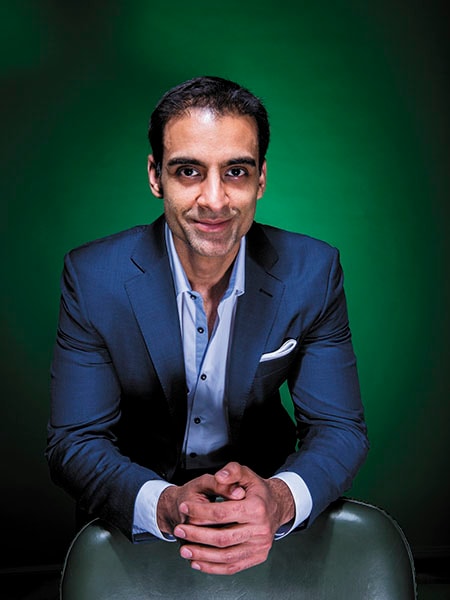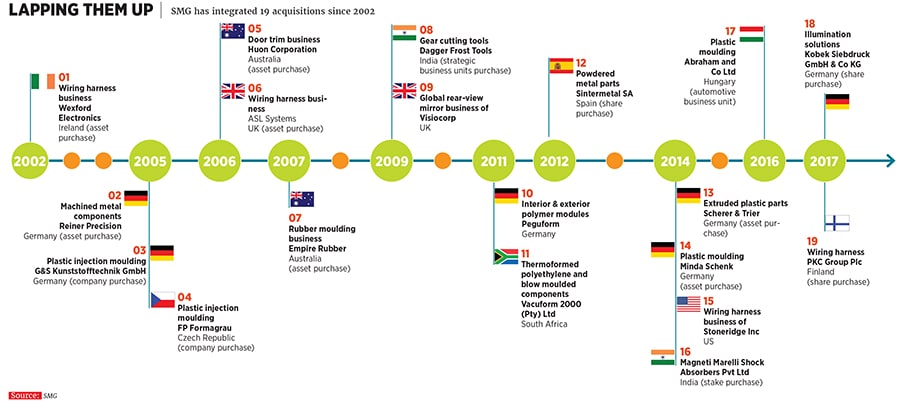Laksh Vaaman Sehgal: Rewiring the future
From turning around an ailing auto component firm in Germany to spearheading innovation solutions at auto parts maker Motherson Sumi, Laksh Vaaman Sehgal is fast stepping out of the shadow of his illustrious billionaire father

Laksh Vaaman Sehgal believes his experience as CEO of the ailing SMR was the game-changing event of his career
Image: Amit Verma
Image: Amit Verma
Few in the corporate world would have been initiated into a family business quite like Laksh Vaaman Sehgal was. Let’s call it baptism by fire.
It happened in June 2009. The top brass of Samvardhana Motherson Group (SMG) had gathered at the Noida headquarters for a strategy review meeting to discuss a massively ailing UK-based firm Visiocorp, which it had just acquired. (Visiocorp, which made rear-view mirrors for cars, was renamed Samvardhana Motherson Reflectec or SMR, after the acquisition was completed in March 2009.) The UK-based company’s losses were so sharp that they had pushed the flagship firm Motherson Sumi Systems Ltd (MSSL) into a loss for the June-end quarter.
Chairman and group co-founder Vivek Chaand Sehgal suddenly pointed to his son Laksh Vaaman, then just 26, and said: “You will be the new CEO of the [ailing] company.”
“When he pointed towards me, I actually looked back to see if someone was standing behind me,” Laksh recalls while speaking to Forbes India, after the FY17 financial results of MSSL were announced in May 2017. (The company has shown a growth of 15 percent over the previous year to notch consolidated revenues of Rs 41,985 crore, with profit of Rs 1,554 crore, up by 20 percent from FY16.)
This announcement, made without Laksh’s knowledge, was his father’s way of initiating his son into the business. But Laksh was apprehensive about leading a firm, let alone with the charge of having to pull it out of the sick bay. The total capital invested in SMR at the time of acquisition was €30 million; MSSL held a 51 percent stake in SMR while a group firm, Samvardhana Motherson Finance Limited, held the balance.
Laksh remembers telling his father that he could not be the CEO as there were several more experienced hands who could lead better. “He laughed and said, ‘Look at the bright side. It [SMR] is in such bad shape that it can’t do worse’,” the now-34-year-old director of MSSL says. “That was a good way to take the pressure off me.”
In fact, not only did the company not do any worse, but in less than a year, Laksh also managed to turn around SMR’s business—which conducted most of its manufacturing in Germany—and navigate MSSL’s financials into positive territory. For the quarter ended December 2009, MSSL reported a profit of Rs 78.05 crore and SMR reported a small but significant standalone profit of Rs 9.16 crore. This was even more creditable given that it was in the backdrop of the global slowdown when most of the manufacturing activity across the world was in a tailspin and the automobile industry faced one of its worst crises in recent decades due to slowing demand.

The SMR turnaround was a significant achievement. Consider its financial health around the time it was acquired: The Rs 22.3 crore loss that it posted in the quarter ended June 2009 pushed MSSL into a loss of Rs 12.88 crore (before considering minority interests) in that period. Even in the subsequent quarter, SMR reported a standalone loss of Rs 24.3 crore.
The then CEO of SMR, an Australian, had asked the Sehgals for two years to effect a reversal but Vivek Chaand Sehgal did not agree, saying that Motherson Sumi would not survive for six months if losses continued to mount. Instead, he chose to entrust his son with the responsibility. Not only did Laksh live up to his father’s expectations, he also avoided the ignominy of a possible jail term: In Germany, the CEO is held liable and can even be jailed if the company runs out of cash.
Not without reason does Laksh believe that the SMR experience was the “game changing” event of his career.
His first move at SMR—and he credits his father for this—was to break down the business into units, so that each manufacturing unit operates like a separate company and finds its own strategy to becoming profitable. This technique helped them keep a close watch on costs and processes. (SMR had 16 plants and a majority of them were loss-making). “The idea was if each and every unit was profitable, the whole company would be profitable. We also got in a lot of financial discipline,” says Laksh, who discussed business decisions with his father on a daily basis during that time. “He was there by my side and allowed me to take decisions.”
They also got rid of all the consultants, who were expensive and not adding too much value, he adds.
The group also tends to not hire people from the outside when acquiring a company. In the case of SMR, some of the top management had decided to leave, but the second rung from Visiocorp’s original staff stepped up to take charge of operations. And in keeping with the group’s practice of moving management away from ownership, Laksh stepped away from SMR in 2014, leaving the management and execution in the hands of an experienced team.

Vivek Chaand Sehgal looks back at Laksh’s initiation at SMR with pride. “When you want to train someone, you should throw them into the storm. Vaaman had just finished his master’s. It was important that he needed to understand the difference between running a group against just [acquiring] bookish knowledge,” Sehgal tells Forbes India by phone from the UAE.
India’s 31st richest, according to the 2016 Forbes India Rich List, with a net worth of $3.6 billion, Vivek Chaand Sehgal co-founded the group with his mother (hence the initial name Motherson) in 1975; it was then into silver trading which it has since stopped. MSSL was formed in 1986, as a joint venture between the Samvardhana Motherson Group and Sumitomo Wiring Systems, and was in the business of manufacturing wiring harnesses. These are the organised set of wires, terminals and connectors that run throughout the vehicle and relay information and electric power towards a smoother functioning.
In terms of organic growth, Motherson Sumi saw itself as a “not yet” company (meaning, there was always the possibility of doing something asked for by customers), says Pankaj Mital, MSSL’s chief operating officer (COO), who has been with the group since the early 1990s. Up until the late ’90s, Maruti Suzuki was MSSL’s main client. As an initial strategic move, Motherson Sumi increased the number of components per car, which meant offering more products. This saw it expanding into plastic parts, later rear-view mirrors and then bumpers, handles, spoilers, tail lights. “We became a company which listened to what its customers (in this case car manufacturers, truck- and two-wheeler makers) say and require,” Mital adds. Acquisitions are also made based on this premise. In the mid-1990s, the company became one of the first Indian companies to announce a five-year sales target and the goal of a 40 percent consolidated return on capital employed (RoCE). And it has met these targets each time. This reflects in its stock performance: The Rs 66,871 crore (market cap as on June 15, 2017) company, which listed in 1993, outperformed the Nifty Auto Index over the last year, with a rise of 62.2 percent against the index’s 25.85 percent.
For FY20, the Sehgals have placed, for MSSL, a target of $18 billion in revenues and $26 billion for the whole group.
To that end, in March, MSSL said that it has completed the acquisition of Finland’s PKC Group for €571 million, which essentially helps the company expand its footprint into the United States region and Europe’s commercial vehicle market. PKC is a manufacturer of truck wiring harnesses, which adds to MSSL’s product mix. “This acquisition made sense for Motherson Sumi, besides adding to their geographical reach,” says Deepak Jain, an analyst with IDFC Securities.
Each acquisition (see box) was successful and the reason, in large part, is how the Sehgals managed them. Both father and son travel in excess of 250 days a year, meeting officials and staff at various factories and companies they have acquired, and their customers. During the heady days of the SMR acquisition, Laksh claims to have flown more than 2.5 million miles in 2009-10—which is more than the distance of the earth to the moon. He says he later received a congratulatory letter from Lufthansa Airlines for this feat.
Now, nearly eight years into the business, Laksh has found his mojo in the form of Motherson Innovations, a firm which sources innovative and technological solutions from across the Samvardhana Motherson Group, to build solutions for the future. “This allows Motherson Innovations to pick and choose the best competencies and solutions in the entire group and make one project deliver a complete solution to the car maker for new technologies. And we can do that in ways the individual companies would not be able to do independently,” Laksh explains the business in a note to shareholders, in MSSL’s 2016 annual report.
Considering that the use of electronics in a car is constantly on the rise, Motherson Innovations is working on projects involving surface-, lighting- and new interior technologies, all of which can be built into the next generation of cars. Laksh’s logic is simple: As cameras get cheaper, manufacturers are more likely to use them. Earlier cars came with radars that were more expensive and harder to use. Laksh sees cameras replacing mirrors and lamps, and this is already happening in some high-end models of sports car brands like the Porsche and Lamborghini. He has set up offices in Silicon Valley, Germany and Australia to work on this technology while the testing and validation are being done in Bengaluru, a low-cost location.
Laksh is also busy putting together a project internally called ‘Dashboard X’, which will explore unique designs and technologies towards building the dashboards of the future. This new project will involve 14 experts from across the US, UK and Germany in the Samvardhana Motherson Group. “We plan to showcase some of our products at the 2018 CES (Consumer Electronics Show) in Las Vegas,” Laksh says, without divulging more details.
Laksh, who is a part of the M&A and technology teams, is involved in the “Cs of the business”, which means understanding customers, collaborators and control of the vision, and has attended all MSSL’s board meetings and the group AGM last year.
Ravi Mehta, managing director of Steadview Capital, an investment fund based in Asia, says: “Laksh is among the best second generation leaders in India I see around.” Steadview Capital invested in MSSL in 2010 and exited in 2016, with 10x returns.
Laksh too wears an investor’s hat in his personal capacity and through the Sehgal Family Venture Fund. In 2006, he helped a close friend Paramdeep Singh set up music streaming platform Saavn (then in its earliest form) by seed funding it during his under-grad years. (Laksh is still one of the largest independent shareholders outside the founders of Saavn). He has also invested in other ventures, including US-based LeagueApps in 2012 and AdvantEdge, an early-stage investor in technology startups, since 2015.
Of course, some of this often happens 30,000 feet above ground. “My challenge is waking up to see where I am, sometimes it is Mexico, Hungary or China,” he says. But he has no complaints: He is well aware of how the future needs to be dealt with. “[One should] try not to predict the future, but we must be the fastest to react to that situation.”
(This story appears in the 07 July, 2017 issue of Forbes India. To visit our Archives, click here.)
X














